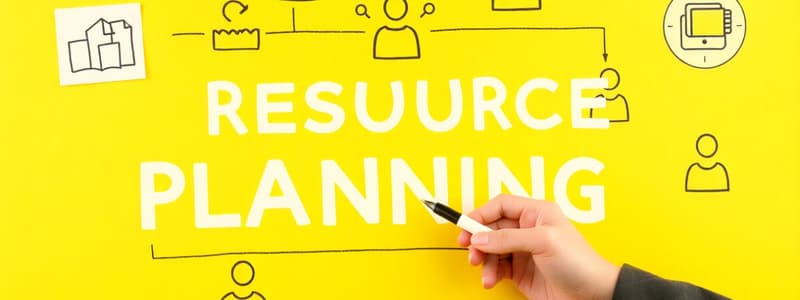Podcast
Questions and Answers
Which of the following is NOT a strategy to address workforce oversupply?
Which of the following is NOT a strategy to address workforce oversupply?
- Suspend hiring
- Encourage overtime (correct)
- Offer career breaks like study leave
- Set limits to overtime
What is the primary focus of job analysis?
What is the primary focus of job analysis?
- Determining compensation packages
- Assessing employee performance
- Analyzing the duties and requirements of the job (correct)
- Identifying candidate qualifications
Which of the following methods is NOT commonly used to collect job analysis information?
Which of the following methods is NOT commonly used to collect job analysis information?
- Using diaries
- Distributing surveys
- Observing current employees
- Interviewing former employees (correct)
Which component is NOT part of important considerations in job analysis?
Which component is NOT part of important considerations in job analysis?
Which of the following work schedule changes is characterized by employees working fewer days but longer hours each day?
Which of the following work schedule changes is characterized by employees working fewer days but longer hours each day?
Which factor does NOT directly affect Human Resource Planning (HRP)?
Which factor does NOT directly affect Human Resource Planning (HRP)?
What is the primary objective of the relationship between Human Resource Planning (HRP) and Strategic Planning (SP)?
What is the primary objective of the relationship between Human Resource Planning (HRP) and Strategic Planning (SP)?
Which of the following best describes the qualitative method of predicting HR needs?
Which of the following best describes the qualitative method of predicting HR needs?
In the HRP cycle, what is the first step that initiates the planning process?
In the HRP cycle, what is the first step that initiates the planning process?
What does supply forecasting aim to predict in Human Resource Planning?
What does supply forecasting aim to predict in Human Resource Planning?
Which of the following is NOT a major consideration in labor demand forecasting?
Which of the following is NOT a major consideration in labor demand forecasting?
What is the role of structural design in Human Resource Planning?
What is the role of structural design in Human Resource Planning?
How does the exactness of forecasting manpower needs influence HRP?
How does the exactness of forecasting manpower needs influence HRP?
Flashcards are hidden until you start studying
Study Notes
Human Resource Planning (HRP)
- HRP is an HR undertaking that determines the company’s present and future HR needs
- HRP connects human resource management and the entire strategic plan of the organization.
Strategic Planning (SP)
- SP is an organization’s process of formulating and implementing its strategies and analyzing their effects on the internal and external environments of the firm.
HRP and SP Relationship
- The main objective is to ensure Human Resource Management activities are considered when forming the corporate plan.
Human Resource Planning Cycle
- Begins with organizational mission, goals, objectives, and strategic requirements
- Involves current manpower inventory
- Needs forecasting demand and supply
- Considers manpower gaps and deciding on action
- Leads to developing an employee plan
Factors Affecting Human Resource Planning
- Company’s goals, objectives, and strategies
- Time spent planning HR needs
- Uncertainties of business activities
- Exactness of forecasting manpower needs
- Structural design of the company
- Internal and external availability of manpower
- Preparation period for positioning talents
Forecasting
- Predicting the demand for labor
- Predicting the supply of labor
- Reconciling the gap between demand and supply of labor
Methods of Predicting HR Needs
- Quantitative Method: Not mentioned in this text.
- Qualitative Method: Includes the Delphi technique.
Predicting the Supply of Employees
- Supply forecasting is part of the Human Resource Planning (HRP) process.
- Supply forecasting determines the number and types of employees available to fulfill the projected demand.
Dealing with Workforce Oversupply
- Suspend hiring
- Set limits on overtime
- Avoid using contingent workers
- Offer early retirement
- Reduce pay
- Implement job sharing
- Offer career breaks like study leave
Dealing with Workforce Undersupply
- Encourage overtime
- Create another work shift
- Reassign jobs
- Strengthen employee retention programs
Job Analysis
- Job or task analysis examines the requirements of the job, not the person holding the job.
- Job analysis gathers information on job duties, necessary requisites, and the needed traits and attributes for successful performance.
Job Analysis Outcomes
- Job description
- Job specification
Collecting Job Analysis Information
- Interviewing current employees
- Observing the activities of current employees
- Distributing survey questionnaires
- Utilizing employee diaries
Important Components of Job Analysis
- Job Content: Describes the tasks and duties of the job.
- Job Context: Explains the environment the job is performed in.
- Worker Requirements: Outlines knowledge, skills, abilities, personal characteristics, and credentials needed for the job.
Changes in Work Schedules
- Compressed workweek
- Flexible time
- Job sharing
- Telecommuting
Studying That Suits You
Use AI to generate personalized quizzes and flashcards to suit your learning preferences.




